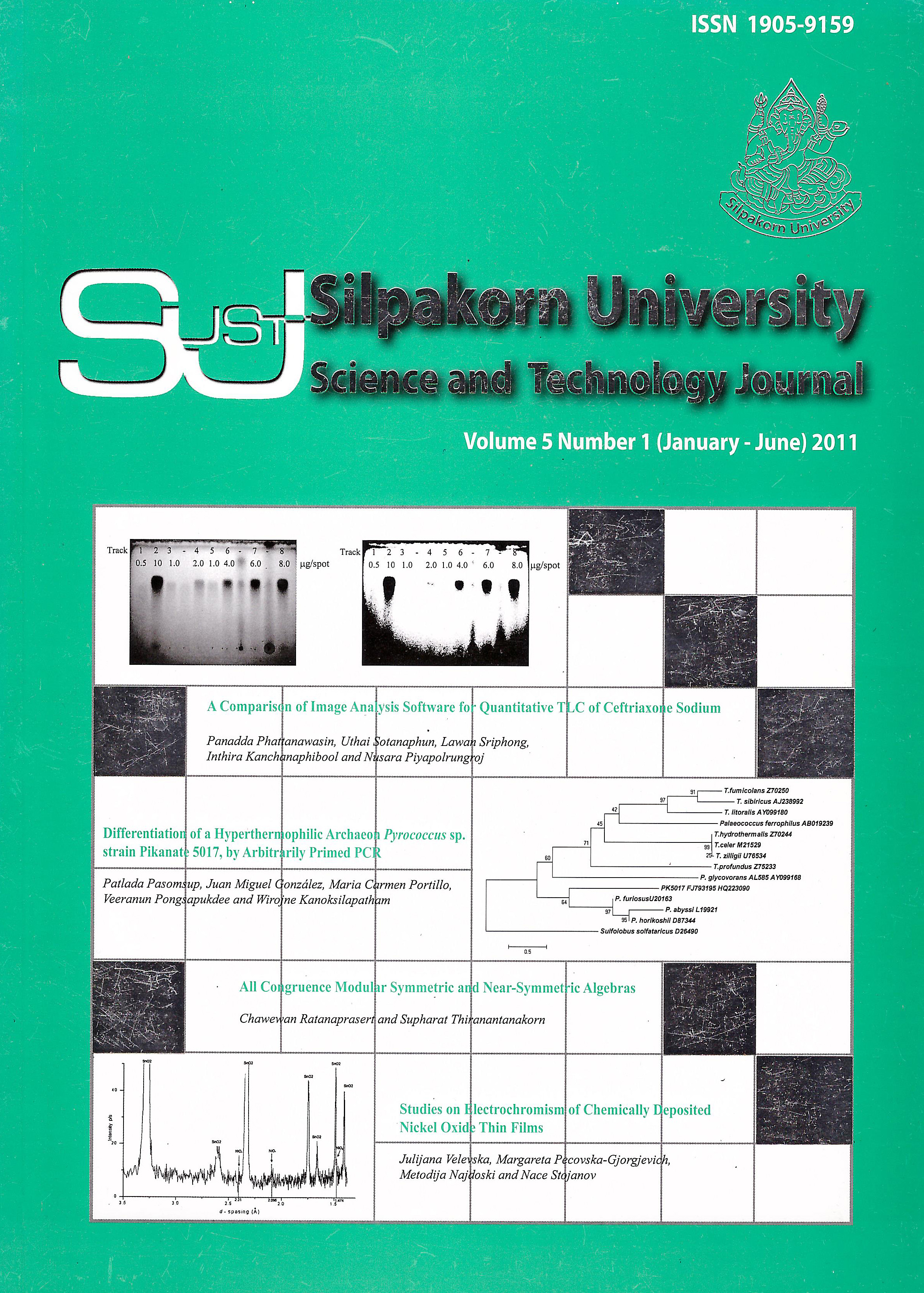A Comparison of Image Analysis Software for Quantitative TLC of Ceftriaxone Sodium
Main Article Content
Abstract
Three image analysis software, Photoshop, Sorbfil TLC Videodensitometer software and Scion Image,were used for quantitative evaluation of TLC images of ceftriaxone sodium (CFX). Regression plots anddetection sensitivity of quantification from each TLC-image analysis were determined and compared toTLC-densitometry. TLC-image analysis method using Scion Image and Sorbfil TLC Videodensitometersoftware and TLC-densitometry showed the polynomial regression data with good relationship (R2 > 0.99)over the concentration range of 1-8 mg/spot whereas the analysis of TLC images with Photoshop showedgood polynomial regression plots (R2 > 0.99) at higher concentration range, 4-10 mg/spot. For detectionsensitivity, LOD and LOQ determined from TLC-image analysis using Sorbfil TLC Videodensitometer werecomparable to the values from TLC-densitometry. Scion Image and Photoshop was found to be less sensitive.The use of Sorbfil TLC Videodensitometer software for TLC image analysis could be further applied forrapid determination of CFX in bulk drug and dosage forms.
Downloads
Article Details
References
Ansari, M. J., Ahmad, S., Kohli, K., Ali, J., and Khar, R. K. (2005). Stability-indicating HPTLC determination of curcumin in bulk drug and pharmaceutical formulations. Journal of Pharmaceutical and Biomedical Analysis, 39: 132-138.
Bebawy, L. L., Kelani, K. E., and Fattah, L. A. (2003). Fluorimetric determination of some antibiotics in raw material and dosage forms through ternary complex formation with terbium (Tb3+). Journal of Pharmaceutical and Biomedical Analysis, 32: 1219-1225.
Dhanesar, S. C. (1998). Quantitation of antibiotics by densitometry on a hydrocarbon-impregnated silica gel HPTLC plate. Part II: Quantitation and evaluation of ceftriaxone. Journal of Planar Chromatography, 11: 258-262.
El-Shaboury, S. R., Saleh, G. A., Mohamed, F. A., and Rageh, A. H. (2007). Analysis of Cephalosporins. Journal of Pharmaceutical and Biomedical Analysis, 45: 1-19.
Eric-Jovanovic, S., Agbaba, D., Zivanov-Stakic, D., and Vladimirov, S. (1998). HPTLC determination of ceftriaxone, cefixime and cefotaxime in dosage forms. Journal of Pharmaceutical and Biomedical Analysis, 18: 893-898.
Gáspár, A., Kardos, Sz., Andrási, M., and Klekner, Á. (2002). Capillary electrophoresis for the direct determination of cephalosporins in clinical samples. Chromatographia Supplement, 56: 109-114.
Hung, T. T. N., Dinh, C. P., and Duc, C. H. (2001). Combination of thin layer chromatography with personal computer for determination of some derivatives of artemisinin. In Proceedings in Pharma Indochina II, Hanoi, Vietnam.
Johnsson, R., Traff, G., Sunden, M., and Ellervik, U. (2007). Evaluation of quantitative thin layer chromatography using staining reagents. Journal of Chromatography A, 1164: 298-305.
Mohamed, F. A., Saleh, G. A., El-Shaboury, S. R., and Rageh, A. H. (2008). Selective densitometric analysis of cephalosporins using Dragendorff’s reagent. Chromatographia, 68: 365-374.
Mustoe, S. P. and McCrossen, S. D. (2001). A comparison between slit densitometry and videodensitometry for quantitation in thin layer chromatography. Chromatographia Supplement, 53: 474-477.
Nabi, S. A., Laiq, E., and Islam, A. (2004). Selective separation and determination of cephalosporins by TLC on stannic oxide layers. Acta Chromatographica, 14: 92-101.
Sotanaphun, U., Phattanawasin, P., and Sriphong, L. (2009). Application of Scion image software to the simultaneous determination of curcuminoids in turmeric (Curcuma longa). Phytochemical analysis, 20(1): 19-23.
Xu, Q. A. and Trissel, L. A. (2003). Stability-indicating HPLC Methods for Drug Analysis, American Pharmacists Associations, Washington, DC.


